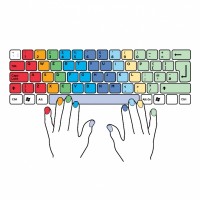Top Ten Tips to Type Faster
We are living on the internet age where typing is essentially an important skill to grasp. You may find yourself struggling on the keyboard or you are just getting started with the touch and type method. Beginners may find typing more complicated than it should be, but that's not really the case. Not only you just type fast, but you also save a big chunk of your time when it comes to work. These are ten tips presented in this list that are guaranteed to increase your WPM. (Words Per Minute)Accuracy is perhaps the most important thing to watch out on your fingers. If you focus on speed, you won't be able to type well enough and you will end up constantly back-spacing every typo you make. Whether you encounter a complicated-looking or an unfamiliar word, slow down a little and focus on the letters that you constantly tend to trip on. That way, you should feel more control your fingers and on the keys you're typing. The fewer mistakes you make, the less of a hassle you need to backspace thus saving a bit of time in your hands. That way, you can build up your WPM speed slowly from time to time.
Typing Apps & Games like Mavis Beacon, Typer Shark, etc. you get the point. If you don't have one of those typing apps, it's better to check out the typing websites as they are more easily accessible. Otherwise, typing apps for beginners are a good alternative to younger kids.
Pangrams are usually short sentences that consist of all the unique letters on the alphabet. Such as the iconic sentence: "The quick brown fox jumps over the lazy dog". This is not only this famous pangram, but other slightly obscure ones such as "the five boxing wizards jump quickly", and "two driven jocks help fax my big quiz". Pangrams are a clever method for exercising and memorizing the fingers of the keyboard when you're mastering the touch typing method.
It doesn't take a full day to reach 20 WPM to 80 WPM nor a short path that would somehow shoot your WPM up in an instant; constant practice is needed for that, and you'll have to go through a long way if you want to reach the professional typing speed. If you're a beginner and haven't got on touch-typing yet, it's recommended to learn the basics and develop the muscle memory for each fingers for each keys first. In the long run, you are able to type much faster and easier without the struggle of having to type with two fingers on each. For more experienced typists, learning and mastering the combinations such as "ea" "th" "ou" "ing" etc. is certainly the most effective on optimizing your WPM, as well as accuracy.

Touch typing involves not looking at the keyboard while you type. This method typically involves the use of each fingers on specific keys, and memorization on which finger to type on the specific key. For example, your left pinky finger should press the Q, A, Z keys, while your left ring finger should press the W, S, X keys, your middle finger should press the E, D, C keys, your index finger should press the R, F, V, T, G, B keys, and both of your thumbs presses the spacebar (though it's recommended to use the left thumb, but that depends on your preference), and so on. You can see the image on the left for a guidance in finger positions.
Bad posture such as slouching your back can affect the way how you type, too. Therefore, it's best to straighten your back and ensure that your feet are down flat on the floor, as well as wrists slightly away from touching the keyboard so that your fingers bend to the keys easily. Have a chair comfortable enough and adjustable in order to type effectively, and also make sure to be as relaxed as possible to avoid pain, especially back pain.
This is especially an effective way for those who tend to have a habit of looking at the keyboard while typing. While it can seem challenging at first, the best way to approach this by whispering or saying the word aloud as you type them. That way, it is easier to memorize the key positions and combinations as you type.
This is optional, but mind if you are struggling with touch typing with the current QWERTY layout and you see little progress on your results, you can switch to the DVORAK or COLEMAK layout which are both made to best make typing more comfortable. It may take some time to adapt with the different key positions, but however, switching may not be effective for some, as you may have to switch again to best suit your style. However, it's not recommended to switch if you are already familiar with the QWERTY layout.
Once you switch to the touch-typing method, don't alter the position of your fingers or stick to your previous method. Sure it will make your fingers seem more comfortable to the keys you type, but you may find typing words a bit awkward and you may require more movement on each of your fingers, and that could impact your accuracy. It's best to stick to the formal method to ensure consistent efficiency and to ensure no bad typing habits would be developed.
If you have been sticking with the touch and type method, it's also essential to keep track of your progress. If your WPM is increasing steadily, then you're in the right track. You may find yourself surprised of the results, but don't let this distract you though. Still stick with prioritizing accuracy over speed so that your comfort with the keyboard will remain as you type faster overtime.